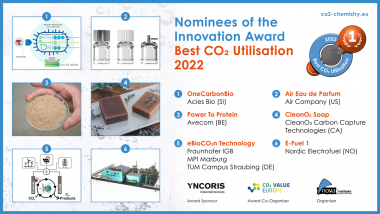Innovationspreis Nominierten “Best CO2 Utilisation 2022”
- Innovationspreis “Best CO2 Utilisation 2022”: Sechs Technologien zur Kohlenstoffabscheidung und -verwertung für eine nachhaltige Chemie- und Kraftstoffproduktion nominiert
- „Conference on CO2-based Fuels and Chemicals 2022“– in Köln und online, hybride Konferenz, 23-24 März 2022
Innovationen des Jahres 2022 in der CO2-Nutzung (Carbon Capture and Utilisation, CCU): Um den Herausforderungen einer nachhaltigen Chemie- und Kraftstoffproduktion zu begegnen, stehen bereits zahlreiche Technologien zur Verfügung, die auf der Nutzung abgeschiedener CO2 Emissionen aus industriellen Abgasen oder direkt aus der Atmosphäre basieren. Zahlreiche weitere befinden sich in der Entwicklung. Um diese Lösungen zu würdigen, vergibt das nova-Institut im Rahmen der „Conference on CO2-based Fuels and Chemicals“ am 23. und 24. März 2022 in Köln jährlich den Preis der „Best CO2 Utilisation“. Auch dieses Jahr erreichten das nova-Institut hervorragende Einreichungen. Sechs Nominierte erhalten nun die Chance, einem breiten Publikum in Köln und online ihr volles Potenzial zu demonstrieren.
Hier sind die sechs Nominierten!
- Acies Bio (SI) – OneCarbonBio
- Air Company (US) – Air Eau de Parfum
- Avecom (BE) – Power To Protein
- CleanO2 Technologien zur Kohlenstoffabscheidung (CA) – CleanO2 Seife
- Fraunhofer-Institut für Grenzflächen- und Bioverfahrenstechnik IGB (DE)
- Nordic Electrofuel (NO) – E-Fuel 1
Best CO2 Utilisation 2022 Nova Institut Acies Bio OneCarbonBio Air Company Air Eau de Parfum Avecom Power To Protein CleanO2 Carbon Capture Technologies eBioCO2n Technology Nordic Electrofuel CleanO2 Soap Fraunhofer Institute for Interfacial Engineering and Biotechnology IGB
Nova Institute








